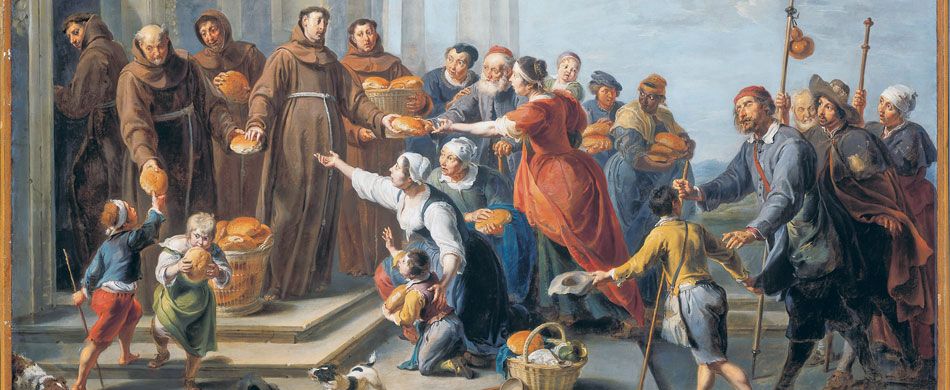THERE is a painting at the National Gallery in London of which I am particularly fond. It shows Saint Anthony with his fellow friars distributing loaves of bread to the poor at the entrance of a church. It was painted in 1662 by the Flemish painter Willem Van Herp who, with exceptional skill, shows us the Saint making one of his most typical gestures: helping the poor.
In Anthony’s times, almost eight hundred years ago, poverty was often marked by the most abject misery and squalor. Living in indigent conditions, the poor had little to no chance of improving their lot, and for them any hope of leading a life of dignity was in vain.
The poor were not even defended by any laws because these were promulgated by the rich and powerful to protect their own rights and privileges. Sometimes, unfortunately, even some members of the clergy, trapped by a human craving for power and riches, paid no attention to their brothers and sisters in whose suffering faces they should have seen the face of Christ. That said, however, the Church as a whole considered aid to the poor to be among its most basic moral imperatives, and it was always at the forefront in caring for the sick and feeding the hungry. Moreover, the Church was also heavily committed to education.
Perhaps one of the most interesting examples of Christian efforts to aid the poor was represented by the Franciscans. In fact, St. Francis of Assisi asked his friars to embrace poverty, both individual and communal. They were to completely eschew greed as humanly possible. And it goes without saying that among the early Franciscans, the one who stood out the most as an example of charity was our very own Saint Anthony.
Countless events bear witness to Anthony’s love for the poorest of the poor, and his tireless effort to urge wealthy people to turn their minds towards real wealth, that of the heart. In one of his Sermons, the Saint exhorts people in this way, “You rich people, make friends with the poor! Welcome them into your homes so that, in their turn, they will welcome you into the Eternal Dwellings where there is the beauty of peace, confidence, security and the wealthy rest of eternal satisfaction.”
Immediately after St. Anthony’s death some charitable associations assisted by the friars arose around the Basilica. Over the centuries they have tended to many poor people and, thanks to the Saint’s constant help from Heaven, they have greatly improved the lives of many poor families. Pope St. John Paul II recalled this fact in 1998, “This is how that precious initiative called Bread for the Poor began. This initiative has always been active, even during the most difficult of times, times affected by misery and poverty like the two World Wars.” The saintly Pope then added, “In time, many of these initiatives merged into today’s St. Anthony’s Charities, which is operating effectively in all continents, and makes the less fortunate feel the balm of brotherly love.”
You, dear readers, are certainly among those who help the poor. For many years you have, in fact, supported the projects of St. Anthony’s Charities as a sign of your love for those less fortunate than ourselves, and of your devotion to the Saint, whose feast day we celebrate this month. He has always believed in the good will of people like you to support initiatives like the one in favor of street children in Burkina Faso for this year’s June 13 project described on page 14 of this issue.
In one of his Sermons, the Saint invites us to behave like the fig tree, “the most fertile of plants, because it bears fruit twice a year, and while one crop is ripening, the other begins to grow. It is the symbol of fraternal charity, more fertile than all the other virtues because it corrects those who make a mistake, forgives those who offend, feeds the hungry, and while it is intent upon carrying out an act of mercy, it is already thinking about another such act.”
May our beloved Saint bless you, and reward you for your generosity. Happy feast of Saint Anthony!




